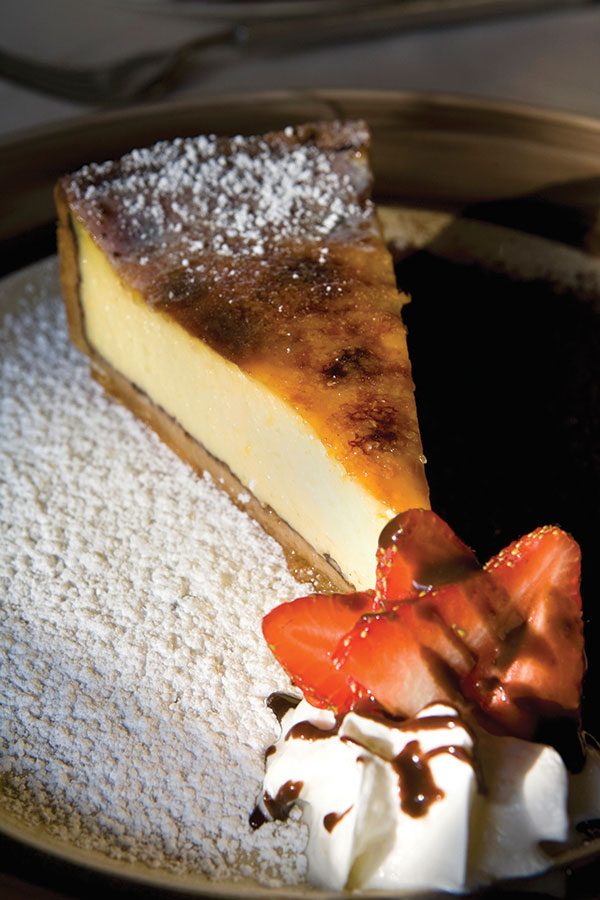




Growing up in a village outside Palermo, Franco Lombardo’s grandmother learned two important lessons that she later passed on to him: “If you can make it yourself, why buy it?” and “You put something on the plate, you eat it all.”
Lombardo took those words to heart. As chef and owner of Sapori Trattoria Italiana, Lombardo makes almost everything from scratch, from house-made pastas to the prune sauce that coats pork medallions to his sublime tiramisù. And Sapori (which means “flavors” in Italian) so consistently lives up to its name that customers have no trouble complying with Nonna Anna’s clean-plate dictum.
Lombardo himself grew up in that same village, Carini, and learned to cook at his grandmother’s side. He studied cooking in Palermo, but that was secondary. “When you are raised in Italy,” he says, “you are born into this kind of cuisine.”
When he came to the United States in 1996 at age 21, Lombardo worked in Los Angeles before becoming chef of La Locanda del Ghiottone in Philadelphia. In 2003 Lombardo was living in Collingswood and, because he was starting a family, decided to create his own place close to home. Sapori opened later that year.
“I wanted to recreate a trattoria like you would find in Italy,” says Lombardo, 33. “In Italy, a restaurant is a more formal place where the waiters wear tuxedos, whereas a trattoria or osteria you can go to every night. It’s a mom-and-pop place where the chef comes out and serves you what he’s making.”
The handsome 64-seat Sapori is a cross between upscale and down-home. In addition to the two-page menu, Lombardo offers eight or nine special appetizers and as many entrées each night. Some customers simply ask for the “chef’s choice”—an off-the-menu four-, five-, or six-course meal that costs $40 to $65 per person.
“For me, it’s an honor,” Lombardo says of the tasting menu. “They’re trusting me with the choices for themselves and their friends.”
Among standout antipasti, slices of buffalo-milk mozzarella that Lombardo imports from Naples are served with imported, air-dried beef bresaola, marinated tomatoes, olives, artichokes, and extra virgin olive oil. A light, naturally sweet lobster salad combines chunks of fresh lobster and cantaloupe with baby arugula and an aromatic vanilla-lime vinaigrette. The arugula salad offers a winning combination of greens, dried figs, walnuts, pears, and gorgonzola in a sweet and pungent balsamic dressing.
Lobster is a winner in the primi piatti, or pasta, category as well. Sautéed with shallots, white wine, and cherry tomatoes, it is served over excellent house-made linguine. A robust veal-pork ragù blends brilliantly with house-made dried chestnut-flour fettuccine, which has a bit more bite than wheat pasta and a sweet-smoky chestnut flavor.
Among secondi piatti, veal scaloppini exemplifies Lombardo’s contemporary touch. He sautés the veal until just tender, with mushroom, figs, and shallots, and serves it in a rich red wine sauce topped with goat cheese. Grilled rack of lamb is stupendous—four deliciously meaty chops marinated in olive oil, herbs, and garlic, served in a port- wine reduction.
Fish of the day is usually Mediterranean sea bass, either grilled or baked in a sea-salt crust. We chose the latter. The tan crust encases the fish, sealing in its moisture. Tableside, a waiter cracks open the shell, releasing the steam, and expertly fillets the fish. While the show was fascinating, the fish became a bit dry by the time it was served. A minute or two less in the oven might solve the problem.
About two years ago, Lombardo shared his prized tiramisù recipe with a friend in return for the friend’s prized crème brûlée recipe. Both are worth saving room for, as are the moist Italian cheesecake, made with ricotta, cream cheese, and mascarpone, and the “crembrucake”—a perfect custard baked in a crunchy flour-and-nut crust. At the end of the meal, everyone is treated to a shot of house-made limoncello.
Lombardo personally trains the highly professional waitstaff. Before he came to America, he spent a few summers in Italy working on a construction crew, which helps explain how he was able to do most of Sapori’s design, carpentry, tiling, and stonework himself.
Lombardo says he wanted the kind of castle-like atmosphere found in Italian trattorias, which are often located in fifteenth- or sixteenth-century buildings. For the restaurant’s signature chandeliers—spiky yellow globes that evoke gladiators’ maces—he turned to Philadelphia lighting designer Warren Muller. Adding to the medieval feel are lion’s-head sconces, stone walls, and rich tapestries and curtains.
Many native Italians make their way here—doctors from Italy doing a stint at area hospitals, dignitaries from the Italian consulate in Philadelphia, as well as people who have lived or vacationed in Italy. “After people come the first time, they want to bring others to impress them,” Lombardo says. “It’s like they’ve discovered a treasure that they want to share with their friends.”
Restaurant Details
- Cuisine Type:European - Italian
- Price Range:Moderate



